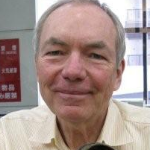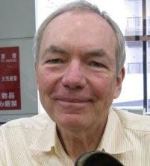It is hard to stand up because I get so stiff when I sit down.
by John F. Fanselow
Every time I find it painful to stand up after a meal either at home or a restaurant, I remember the title of this blog, which is a comment one of my aunts used to make every time she moved from a sitting to a standing position.
About 25 years ago, while I was living in New York I began to feel a lot of back pain after I sat a long time or walked a lot. I mentioned this to a friend who was a professional piano player. She said that she had begun to experience a lot of back pain a few years earlier both during her practice and when she was performing. A fellow musician suggested she visit a practitioner of The Alexander Technique.
I am now living in Japan so when I remembered how my back pain decreased when I worked to change the habits of how I stood, sat and walked in New York, The Alexander Technique did not come immediately to mind as a way to alleviate my pain. But out of the blue one of my wife’s graduate students who is a nurse mentioned in a conversation that her sister was an Alexander Technique practitioner!
We called her immediately and I have now had two sessions with her. Though it has been 25 years since I last had a session, after both sessions I felt as if I was re-living the sessions 25 years ago in New York.
I will not tax your mind with loads of a lot of details about what the Alexander Technique is about, just a few details. Frederick Alexander was an actor who was born in Australia in 1869. As a young man he was frustrated because though he could speak with no problems with friends, when he stood on a stage to recite Shakespeare he lost his voice. He decided to compare his posture when he spoke with friends and when he was on stage to recite Shakespeare. He noticed great differences between how he stood and moved in both settings.
Over time, he was able to overcome his loss of voice by standing on stage the same way he stood when he was chatting with friends.
You can find many more details about his life and his technique on the Internet. I just want to point out one lesson that I have been reminded of and learned in the two sessions I have just experienced in Japan.
In Japan, the chairs I sit in at our dining room table are about 4 inches/12 centimeters lower than the ones I sit on in New York. This means that when I sit in a chair in Japan my legs between my knees and my pelvis are pointing up rather than parallel with the floor. This puts a great deal of strain on my legs and back.
I have now put a 4-inch/12 centimeter pad on the chair I sit in when I eat. I can now sit down and stand up without putting my hands on the arms of the chair to ease me into either a sitting or standing position.
I had lunch with a person 25 years younger than I am last week in our apartment—American like me. He is the same height as I am. When he sat down I noticed that he braced himself on the arms of one of our dining room chairs. And when he stood up he propped himself up putting his hands on the arms of the chairs. His habits were the same as mine and just as detrimental to the long-term negative effects on our bodies.
I am excited by the Alexander Technique not only because I have found it beneficial to the way I sit, walk, stand and lie down but also because I think that Alexander has lessons for teachers that are in line with what I have been advocating for many years. I am not promoting the Alexander Technique for you to deal with your back pain, though I think it will alleviate it. Rather I am promoting Alexander’s ideas because they are in tune with what I have been advocating for decades to better understand our teaching.
1. Most of what we do is out of consciousness—I call this following rules and Alexander calls it following habits.
2. To change how we teach or sit or stand, we need to observe in minute detail a minute or two of our behaviors. Then we have to change one of our behaviors slightly. If we sit on a chair that is too low for us so that our legs between our knees and pelvis are pointing upward rather than parallel with the floor, we need to put something on the chair seat so our legs are parallel with the floor.
If students use erasers during dictations so that you cannot see what words they wrote incorrectly you have to ask them to put their erasers in their pencil cases so that you can see what they wrote and how it is similar and different from what you said.
Small changes and no judgments! Alexander used the word “habits” because he had no interest in judging people about having bad posture or bad habits of sitting or walking. He just wanted people to learn awareness of how if they sat or stood or walked one way or another there would be different consequence. Ditto my long-term call to be descriptive and analytical rather than judgmental. The rules or habits we follow are inculcated in us through years. To make even small changes — something both Alexander and I advocate — requires that we are non-judgmental. - John F. Fanselow
Connect with John and other iTDi Associates, Mentors, and Faculty by joining iTDi Community. Sign Up For A Free iTDi Account to create your profile and get immediate access to our social forums and trial lessons from our English For Teachers and Teacher Development Courses.

